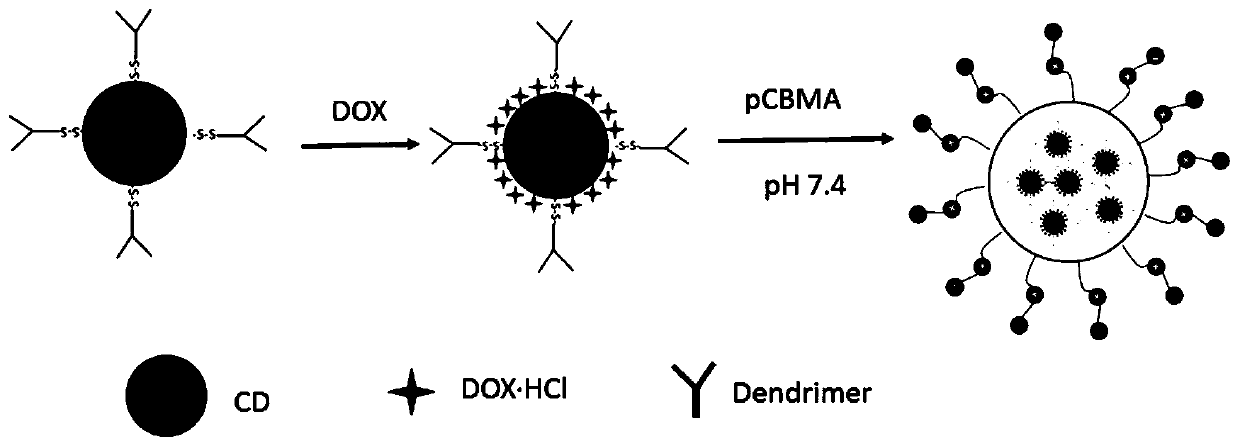A tumor microenvironment-responsive nanoparticle based on peptide dendrimer modified fluorescent carbon dots and its preparation method
A technology of tumor microenvironment and fluorescent carbon dots, which is applied in the field of biomedical materials, can solve the problems of slow release of drugs from drug-loaded nanoparticles, poor anti-tumor effect and safety, and high protein adsorption, so as to improve the anti-tumor effect and reduce the The effect of clearing and exerting the medicinal effect
- Summary
- Abstract
- Description
- Claims
- Application Information
AI Technical Summary
Problems solved by technology
Method used
Image
Examples
Embodiment 1
[0049] Example 1 Preparation of nano-fluorescent carbon dots
[0050] Preparation of nano-fluorescent carbon dots by microwave heating: dissolve 4g glucose in 6mL water and mix, add 20mL PEG200 under stirring conditions, stir and mix well, then place it in a microwave oven and microwave at 800W for 3min to obtain brown The black viscous liquid was cooled to room temperature, diluted with a small amount of water, then added to a 3500kD dialysis bag, dialyzed with deionized water overnight, passed through a 0.45μm filter membrane, diluted with deionized water to the 100 mL to obtain a nano-fluorescent carbon dot solution with a concentration of 3.0 g / mL.
[0051] Infrared analysis, particle size and TEM morphology analysis were performed on the prepared nano-fluorescent carbon dots; figure 2 The particle size distribution and TEM image are shown in image 3 shown.
[0052] Depend on figure 2 It can be seen that at 3370cm -1 The peak at 1644cm belongs to the stretching vib...
Embodiment 2
[0055] Example 2 Preparation of thiolated fluorescent carbon dots
[0056] Take 80 mL of the prepared nano-fluorescent carbon dot solution, add EDC (1.31 g, 6.84 mmol) and NHS (0.78 g, 6.84 mmol), stir and activate for 30 min, then add cystamine (0.52 g, 3.42 mmol), stir and react overnight in the dark , after the reaction, the resulting solution was added to a 3500kD dialysis bag for dialysis for 24h. The dialysate was deionized water. The dialysate was changed every 4h. The obtained solution was further added to the dialysis bag for dialysis for 48h, the dialysate was changed every 4h, the dialysate was collected, and after freeze-drying, a brown solid was obtained, which was the thiolated nano-fluorescent carbon dots.
[0057] make the product 1 H-NMR scan, nuclear magnetic spectrum such as Figure 4 (b).
Embodiment 3
[0058] Example 3 Preparation of Arginine-Lysine Grafted Second Generation Peptide Dendrimer
[0059] Take methyl ester-protected lysine H-Lys-OMe (5.00 g, 21.51 mmol), N-tert-butoxycarbonyl-N'-(2,2,4,6,7-pentamethyldihydrobenzofuran -5-sulfonyl)-L-arginine Boc-Arg(Pbf)-OH (27.18 g, 51.61 mmol), EDC HCl (9.89 g, 51.61 mmol) and HOBT (6.97 g, 51.61 mmol) were placed in 100 mL In the branch-necked flask, vacuumize-nitrogen cycle three times, add 30 mL of dichloromethane under nitrogen and stir to dissolve, then slowly add DIEA (25.58 mL, 154.83 mmol) under ice bath conditions, react at room temperature for 24 h, and collect the reaction solution , the solvent was removed by rotary evaporation, and 60 mL of chloroform dissolved product was added. The dissolved product solution was washed several times with HCl aqueous solution (1 mol / L), NaOH aqueous solution (1 mol / L) and saturated NaCl solution, and the chloroform solution of the organic phase was collected. , added an appropri...
PUM
| Property | Measurement | Unit |
|---|---|---|
| particle diameter | aaaaa | aaaaa |
| particle size | aaaaa | aaaaa |
| particle diameter | aaaaa | aaaaa |
Abstract
Description
Claims
Application Information
 Login to View More
Login to View More - Generate Ideas
- Intellectual Property
- Life Sciences
- Materials
- Tech Scout
- Unparalleled Data Quality
- Higher Quality Content
- 60% Fewer Hallucinations
Browse by: Latest US Patents, China's latest patents, Technical Efficacy Thesaurus, Application Domain, Technology Topic, Popular Technical Reports.
© 2025 PatSnap. All rights reserved.Legal|Privacy policy|Modern Slavery Act Transparency Statement|Sitemap|About US| Contact US: help@patsnap.com



